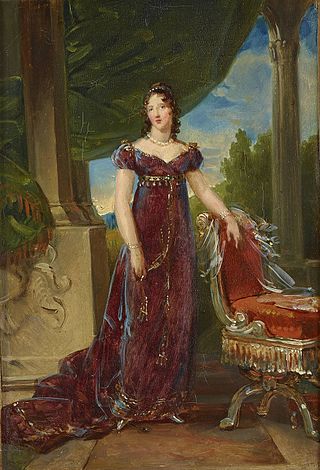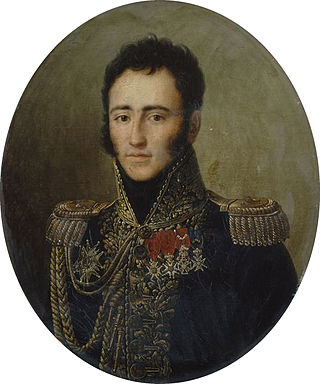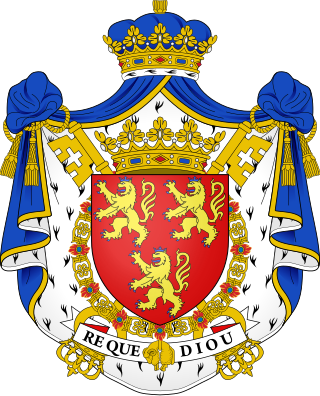
Charles-Maurice de Talleyrand-Périgord, 1st Prince of Benevento, then Prince of Talleyrand, was a French secularized clergyman, statesman, and leading diplomat. After studying theology, he became Agent-General of the Clergy in 1780. In 1789, just before the French Revolution, he became Bishop of Autun. He worked at the highest levels of successive French governments, most commonly as foreign minister or in some other diplomatic capacity. His career spanned the regimes of Louis XVI, the years of the French Revolution, Napoleon, Louis XVIII, and Louis Philippe I. Those Talleyrand served often distrusted him but, like Napoleon, found him extremely useful. The name "Talleyrand" has become a byword for crafty and cynical diplomacy.

Dorothea von Biron, Princess of Courland, Duchess of Dino, Duchess of Talleyrand and Duchess of Sagan, known as Dorothée de Courlande or Dorothée de Dino, was a Baltic German noblewoman, and the ruling Duchess of Sagan between 1845 and 1862. Her mother was Dorothea von Medem, Duchess of Courland, and although her mother's husband, Duke Peter von Biron, acknowledged her as his own, her true father may have been the Polish statesman Count Aleksander Batowski. For a long time, she accompanied the French statesman Charles Maurice de Talleyrand-Périgord; she was the separated wife of his nephew, Edmond de Talleyrand-Périgord.

The House of Talleyrand-Périgord is an ancient French noble house. A well-known member of this family was Charles Maurice de Talleyrand-Périgord (1754–1838), who achieved distinction as a French statesman and diplomat. The family name became extinct in 2003 upon the death of Violette de Talleyrand-Périgord.

Esprit Victor Elisabeth Boniface de Castellane, comte de Castellane, was a French military officer and ultimately a Marshal of France.

Edmond de Talleyrand-Périgord, 2nd Duke of Talleyrand, 2nd Duke of Dino, was a French general of the Napoleonic Wars.

Charles Guillaume Frédéric Boson de Talleyrand-Périgord, prince of Sagan, duke of Sagan and duke of Talleyrand was a famous French dandy, and the grandson of Dorothea von Biron.
Joséphine Pauline de Talleyrand-Périgord, Marquise de Castellane was a French noblewoman.

Marie Pierre Louis Hélie de Talleyrand-Périgord, 5th Duke of Talleyrand and Dino, Prince, then Duke of Sagan, was a French socialite and son of Boson de Talleyrand-Périgord.
Marie Valentine Joséphine de Sainte-Aldegonde, Duchess of Dino was the wife of Alexandre Edmond de Talleyrand-Périgord, 3rd Duke of Dino, and mistress of Anatoly Nikolaievich Demidov, 1st Prince of San Donato.

The Duchy of Żagań or Duchy of Sagan was one of the duchies of Silesia ruled by the Silesian Piasts. Its capital was Żagań in Lower Silesia, the territory stretched to the town of Nowogród Bobrzański in the north and reached the Lusatian Neisse at Przewóz in the west, including two villages beyond the river.

Duke of Fernandina is a hereditary title in the peerage of Spain. It was granted by King Philip II to García Álvarez de Toledo y Osorio, Viceroy of Sicily and Catalonia, and later Marquis of Villafranca del Bierzo in inheritance from his elder brother. It was conferred on him the 24 December 1559, along with the principality of Montalbán. Fernandina is the only dukedom in Spain that is not attached to a Grandeeship. Its name makes reference to the town of Ferrandina in southern Italy.

Ambroise-Polycarpe de La Rochefoucauld GE, 1st Duke of Doudeauville, was a French soldier and politician. He was Minister of the Royal Household from 1821 to 1827.

Napoléon-Louis de Talleyrand-Périgord, duc de Valençay, 3rd duc de Talleyrand-Périgord was a French aristocrat, soldier and politician.

Duke of Talleyrand was a French noble title that was created in 1814 for the House of Talleyrand-Périgord. The title became extinct in 1968.
Charles Maurice Camille de Talleyrand-Périgord, 4th Duke of Dino, 2nd Marquis de Talleyrand was a French aristocrat, soldier, and author who married two different American heiresses.
Elizabeth Beers-Curtis de Talleyrand-Périgord, Marquise de Talleyrand was an American heiress who married into the French aristocracy.

Paul Louis Marie Archambault Boson de Talleyrand-Périgord, 6th Duke of Talleyrand and Duke de Valençay, Prince, then Duke of Sagan, was a French nobleman and son of Boson de Talleyrand-Périgord.
Adele Livingston de Talleyrand-Périgord, Marquise de Talleyrand, Duchess de Dino was an American heiress and philanthropist, known for her two marriages.
Nicolas Raoul Adalbert de Talleyrand-Périgord, 7th Duke of Montmorency, was a French aristocrat.
Béatrice de Andia was a Spanish-French writer and curator.












